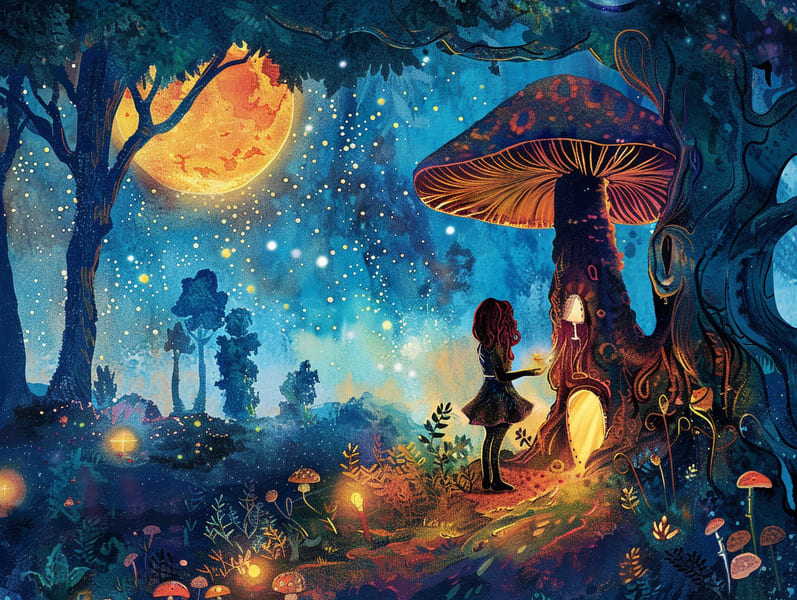
Famous fairy tales have deep roots. These narratives have been spoken from one generation to the next far before they were ever put on paper. They came from a variety of backgrounds, including European traditions. They were initially told among mature audiences, often carrying themes and messages related to the societal norms and beliefs of the time.
Jacob and Wilhelm Grimm, Jacob and Wilhelm, were among the first to gather and publish many of these beloved stories. Their compilation, "Grimm's Fairy Stories," included stories like "Cinderella," "The Bread Crumb Trail," and "Little Snow White," which have since become essentials in the world of children's fairy tales. Similarly, the Danish author's fantastical stories, such as "The Story of the Little Mermaid," and "The Ugly Duckling," have enchanted hearts worldwide, solidifying their place in the pantheon of timeless fairy tales.
Though they are old, these tales remain as pertinent as ever, especially as nighttime stories for kids. These whimsical stories are now available in various formats, including vibrantly illustrated books, fantastical animations, and free fairy tales online.
Their unwavering allure can be connected to several fascinating points:
Moral Lessons: Old fairy tales often teach important moral lessons. Narratives like "The Story of the Boy Who Cried Wolf" teach the value of truth, while "The Tortoise and the Hare" highlight the qualities of resolve and unpretentiousness. These narratives offer kids clear distinctions between virtue and vice, molding their moral compass in a subtle yet deep way.
Warmth and Understanding: Fairy tales frequently involve beings facing obstacles and hardships, prompting children to feel with their struggles and cheer for their triumphs. For instance, "Beauty and Her Beast" teaches us the value of looking past the exterior to comprehend the inner self of a person, building compassion and awareness.
Cultural Awareness: Many ancient fairy tales are deeply ingrained in the cultural contexts from which they arose. Engaging with these narratives can provide informative snapshots into different cultures, cultivating a sense of global awareness and knowledge.
Inventiveness and Imagination: The magical elements in old fairy tales—magic wands—fuel children’s fantasy worlds. These fairy tales carry readers to magical realms, encouraging creative ideas and a sense of magic that stays a lifetime.
Classic fairy tales are not only captivating but also educational. They function as fascinating tools in advancing various cognitive and emotional skills in young readers. When traditional fairy tales are recited, they nurture language proficiency by teaching new lexicon and elaborate sentence structures. This practice also improves listening skills and attentiveness, as children stay focused, eager to see what happens next.
Furthermore, analyzing the themes and characters of old fairy tales can strengthen intellectual skills and logical thinking. Young readers are guided to notice patterns, make predictions, and figure out cause and effect. These explorations also advance young readers utter their thoughts and feelings, boosting their emotional intelligence.
In today’s technological era, the accessibility of web-based fairy tales has made these tales more accessible than ever. Websites and software provide extensive collections of popular fairy tales that can be looked at or listened through anytime, anywhere. Fairy tales spoken are particularly liked, making available an interactive way for children to engage with these charming stories. Sound books and spoken videos guide characters and settings to life, often augmented by bewitching background sounds and soundtracks that enhance the narrative experience.
The lasting appeal of ancient fairy tales lies in their ability to adjust to changing times while maintaining their underlying messages. Contemporary modernizations of these narratives often feature more different characters and modern settings, making them familiar to today’s audience. However, the essential messages of valour, sympathy, and integrity remain unchanged, continuing to resonate with young listeners of all ages.
Old fairy tales also offer a sense of coziness and homeliness. They impart a orderly narrative with a obvious beginning, middle, and end, often finishing with the closure of conflicts and the triumph of virtue over corruption. This reliability can be calming for young ones, spreading a sense of invariability in an inconstant world.
Classic fairy tales continue to fascinate and educate new generations, maintaining their magic and importance in modern society. As children's bedtime stories, they share a perfect blend of magic and knowledge, enhancing moral values, empathy, and creativity. The existence of internet fairy tales and the favor of fairy tales read aloud affirm that these ancient stories remain attainable to new generations.
By continuing and imparting these tales, we continue to treasure the rich tapestry of storytelling and cultural heritage. Whether you are discovering a artistically illustrated book, exploring a electronic collection, or listening on an audiobook, the majesty of classic fairy tales is always within reach. These tales demonstrate of the enduring strength of storytelling and its ability to link us across generations and cultures.
Be it you are seeing a colorful picture book, seeing a web-based collection, or listening through an spoken story, the mystique of bedtime fairy tales is always within reach.
These narratives teach us of the steadfast effect of stories and its ability to draw us together across eras and regions, establishing a link that enchants and click here educates alike.